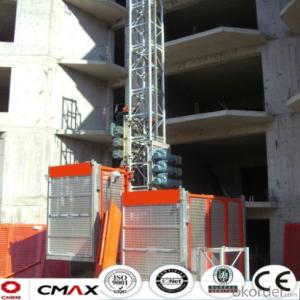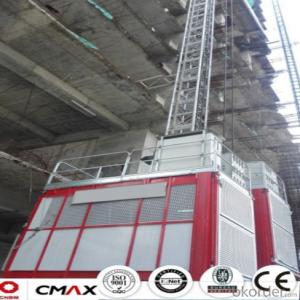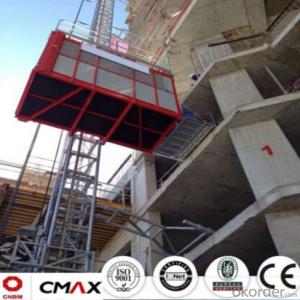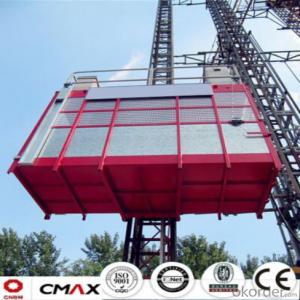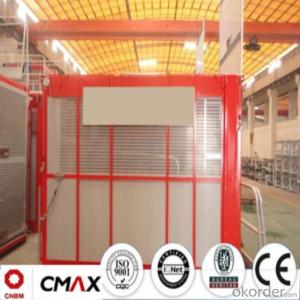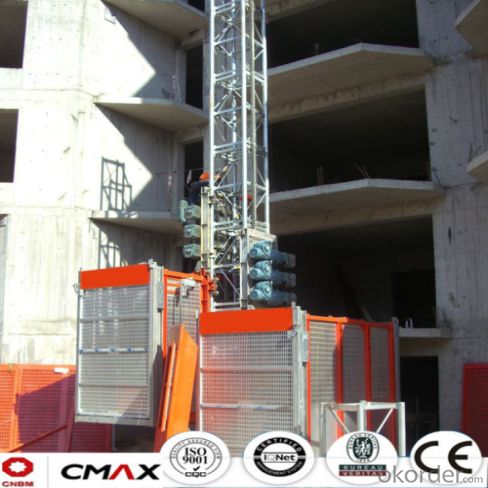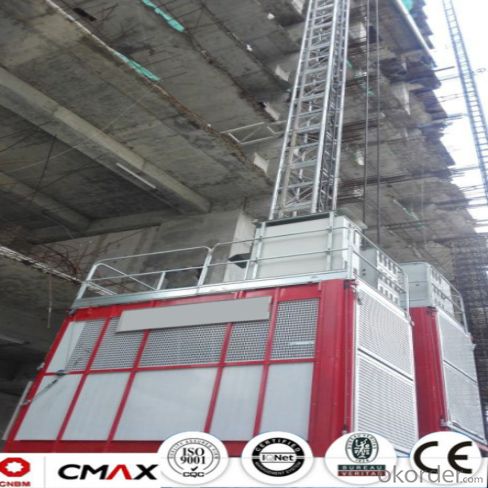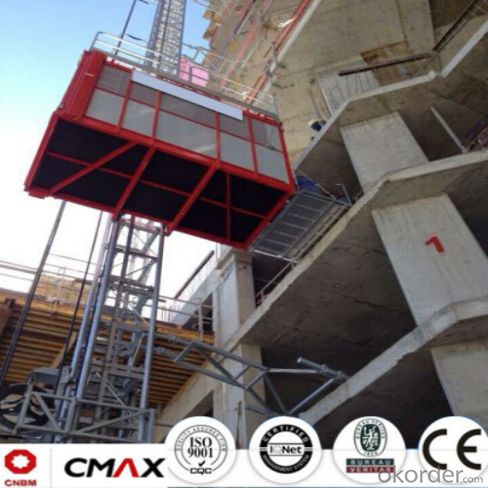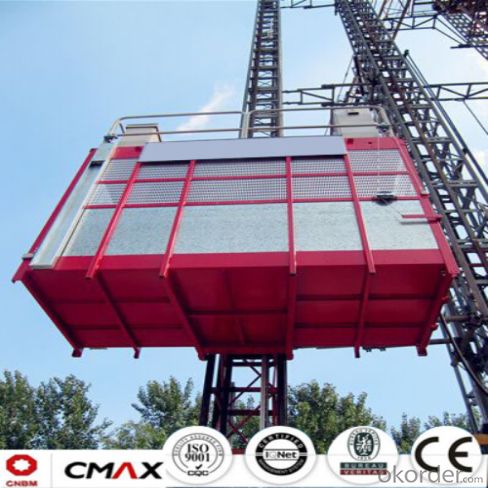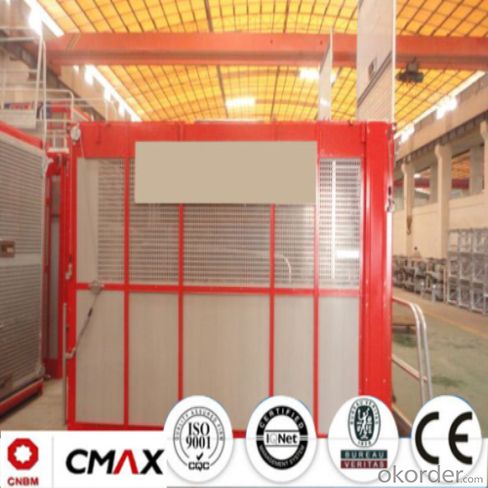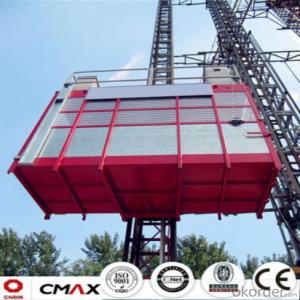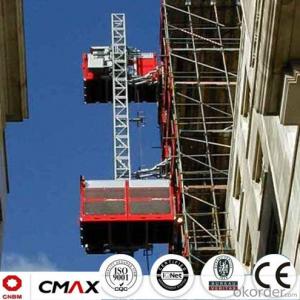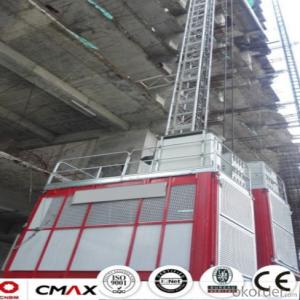Building Hoist Mast Section Spare Parts Manufacturer with 5ton
- Loading Port:
- China main port
- Payment Terms:
- TT OR LC
- Min Order Qty:
- 1 unit
- Supply Capability:
- 5 unit/month
OKorder Service Pledge
OKorder Financial Service
You Might Also Like
Structure of Building Hoist Description
1.The gearing select perfect bearing,strong cables and oil seal.
2.The electrical parts select products from famous world manufacturers for example Schneider,Siemens and LG.
3.The racks and pinion select advanced material and advanced technique,which enhance the life of all parts.
4.The steel structure adopted strong steel from famous native manufacturers.
5.The surface of the steel structure can adopt paint-spray,parkerizing baking finish or hot galvanizing processing depending on users requirement.
6.The cage can be made and decorated by aluminum molded board,punched-plate or figured aluminum board.
Packaging & Delivery of Building Hoist
Packaging: nude and wooded box Delivery: 25-30days
Mains Parts of Building Hoist
1.The steel structure for example the mast, tie in and cabin ,could be all spay-painted and hot galvanized. Mast section is made with high quality Q345B which is the top standared in China.
2.Electrical parts are all adopted with Schneider , Siemens and other famous brands.
3.The electrical system can be selected with the normal control method and VVVF+PLC control way. Inverter we selected is from Schneider. Yaskawa or other world renowned brand.
4.Cabin exit door select ramping type. The ramping door looks like a bridge between the construction hoist and construction building.
5.The cabin floor is made from 3MM thickness steel riffled board(Hot dip galvanized), and 15MM thickness wooden board which can reduce the vibration and deformation a lot.
6.Driving unit is adopted the products from ZHANGJIANG and other reputed maker, or from SEW, NORD.
7.Safety system is mainly composed of electrical motor braking, anti-drop safety device, top & bottom limit switches, top & bottom 3-phase switches, door limit switches, buffer device and over-load protection. The system aims to ensure the hoist are running safely.
8.Qualification: CE, ISO9001:2008 and etc.
9.The long-term operation of CMAX building hoists testifies CMAX hoist is working performance is stable.
Building Hoist Images



Building Hoist Specification

FAQ of Building Hosit
Q: What is the building hoist main purpose?
A: Building hoist equipped with double or single cabin to transport the materials and labors up and down. It's the ideal construction equipment for vertical transportation in the field of construction.
Q: What is the main structure of building hoist?
A: The P/M construction hoist mainly contains metal structure, driving system, electrical control system, cable guide & protection system, electrical top crane and safety device.
Q: What is the meaning of the building hoist’s code?
A: Take SC200/200 for example: “SC” stands for rack and pinion hoist, “200/200” stands for double cage and capacity is 2 tons per cage. “SC200” stands for single cage and capacity is 2 tons.
Q: What is the dimension of the cage?
A: Normally the cage dimension is 3X1.5X2.5M (L/W/H) for 2t type hoist. Details should be checked according to our
quotation sheet. Also, the size can be customized according to the factual site condition. There are two doors (entrance& exit doors) for each cage, It can be produced as up & down sliding or ramping model for safety and convenience.
- Q: What is the function or use of constructing a building hoist?
- <p>The purpose of building hoists is to facilitate the vertical transportation of materials, equipment, and sometimes personnel during the construction process. They are essential for moving heavy items to various floors or levels of a building under construction. Hoists enhance efficiency, reduce manual labor, and improve safety by minimizing the risk of accidents associated with manual handling of heavy loads. They are particularly crucial in high-rise construction where access is limited and the volume of materials to be moved is substantial.</p>
- Q: What are the safety measures to be taken to avoid accidents involving lifting equipment on construction sites?
- <p>To prevent accidents related to lifting equipment in construction work, several key safety measures should be implemented. These include regular inspections and maintenance of lifting equipment to ensure it is in good working order. Operators must be trained and certified for the specific equipment they are using. Safe lifting practices should be followed, such as using proper lifting techniques, not overloading equipment, and ensuring the load is balanced. A thorough risk assessment should be conducted before each lift, and a competent person should supervise the operation. Additionally, clear communication protocols should be established, and all workers should be trained in recognizing and avoiding hazards associated with lifting equipment.</p>
- Q: This question asks for a comparison between lifting equipment used in indoor settings versus those used outdoors, focusing on their differences.
- <p>Indoor lifting equipment is designed for controlled environments, often smaller and more precise, with features like electric chain hoists or jib cranes. They are typically quieter, require less maintenance, and are suitable for tasks like assembly, manufacturing, and warehouse operations. Outdoor lifting equipment, such as gantry cranes or mobile cranes, is built to withstand harsh weather conditions, has higher load capacities, and is often used for construction, shipping, and heavy industry. These are more robust, may require more maintenance, and are designed for larger, heavier loads over uneven terrain.</p>
- Q: Is it possible to integrate a single-rope lifting mechanism into an electric-hydraulic lifting system?
- <p>Yes, a single-rope lifting system can be used in an electric-hydraulic lifting system. The electric-hydraulic system provides the power to lift and lower the load, while the single-rope system manages the vertical movement of the load. This combination allows for precise control and can be advantageous in applications requiring both the lifting capacity of hydraulics and the simplicity of a single-rope system. However, the design must ensure compatibility between the mechanical and hydraulic components to function effectively and safely.</p>
- Q: What factors should be considered when selecting an appropriate building hoist for a specific construction project?
- <p>Choosing a suitable building hoist involves assessing several factors: the weight capacity required, the frequency of use, the height and number of floors in the building, the size and shape of materials to be lifted, and safety features. Consider the hoist's speed and efficiency, as well as its ease of installation and maintenance. Consult with hoist manufacturers or experts to ensure the hoist meets local safety regulations and fits the project's specific needs. Always prioritize safety, reliability, and compatibility with the construction workflow.</p>
- Q: What is the capacity range of a building hoist in terms of lifting objects?
- <p>A building hoist can be used for lifting both large and small objects, depending on its design and capacity. These hoists are engineered to handle various weights, typically ranging from a few hundred pounds to several tons. The specific size and weight of the objects that can be lifted are determined by the hoist's lifting capacity, which is a crucial factor to consider when selecting a hoist for a particular job. It's important to ensure that the hoist's capacity exceeds the weight of the objects to be lifted for safety and efficiency.</p>
- Q: This question asks for the steps or methods to fix a building hoist that is not working properly.
- <p>To repair a malfunctioning building hoist, first, ensure the hoist is powered off and disconnected from any power source to ensure safety. Inspect the hoist for visible damage or loose parts. Check the motor, cables, and control panel for any signs of wear or damage. If the issue is mechanical, such as a stuck cable or a jammed pulley, disassemble the affected parts and clean or replace them as necessary. For electrical issues, inspect the wiring and connections for any shorts or breaks. Consult the hoist's manual for troubleshooting guides specific to the model. If the problem persists or if you're unsure about any steps, it's best to contact a professional technician for repair to avoid further damage or safety hazards.</p>
- Q: What are the key safety rules and regulations that must be followed when operating a building hoist?
- <p>Safety regulations for using a building hoist include ensuring that the hoist is inspected and certified by a qualified person before use. Operators must be trained and certified. The hoist should be used only for its intended purpose, and load limits must never be exceeded. Regular maintenance and checks are required to ensure the hoist remains in good working order. Safety devices such as limit switches and emergency stops must be operational. The hoist area should be kept clear of obstructions, and warning signs should be posted. Personal protective equipment (PPE) must be worn by operators and anyone in the vicinity. Overhead protection should be provided to prevent objects from falling onto the hoist. Compliance with local and national regulations is also crucial.</p>
- Q: How does the construction elevator add up
- With the popularity of construction lifter to use, but knowledge of the user of this kind of special equipment, and makes the construction lifter in use process safety accident frequency is higher and higher, it is necessary to everyone together to discuss how to eliminate the safety hidden trouble as possible. This paper makes a concrete analysis on the use of the construction elevator during the use of the elevator.
- Q: What is the capability of a building hoist in terms of lifting large objects?
- <p>Yes, building hoists are designed to lift and transport large objects in construction settings. They have a high load capacity, often ranging from several hundred to several thousand kilograms, depending on the model and specifications. Building hoists are equipped with safety features to ensure secure lifting and are commonly used for moving materials such as cement, bricks, and heavy equipment within multi-story buildings under construction. However, it's crucial to adhere to the manufacturer's guidelines regarding weight limits and safety protocols to prevent accidents.</p>
Send your message to us
Building Hoist Mast Section Spare Parts Manufacturer with 5ton
- Loading Port:
- China main port
- Payment Terms:
- TT OR LC
- Min Order Qty:
- 1 unit
- Supply Capability:
- 5 unit/month
OKorder Service Pledge
OKorder Financial Service
Similar products
Hot products
Hot Searches
Related keywords
